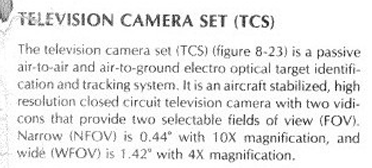Lantirn TGP inconsistent resolution:
https://community.gaijin.net/issues/p/warthunder/i/TYyEmmKu5lgO
Lantirn TGP angular limits:
https://community.gaijin.net/issues/p/warthunder/i/4TBNnByBG63x
Lantirn TGP inconsistent resolution:
https://community.gaijin.net/issues/p/warthunder/i/TYyEmmKu5lgO
Lantirn TGP angular limits:
https://community.gaijin.net/issues/p/warthunder/i/4TBNnByBG63x
I got a photo of the cockpit of F-14A late, which is much cleaner.
Probably the most clear photo that can be found on Google.
And yes, you can see AN/ALR-67 display on cockpit.
F-14A Tomcat - Exhaust Nozzle Position Indicator doesn’t work
F-14A Tomcat - Incorrect Engine Nozzle Position in Afterburner
Hey guys, does the radar showing negative miles on PD Mode mean it’s able to detect behind it, or is it something else?

It’s PDV mode
Targets are shown as a function of closure rate, not range
It’s definitely not able to track behind itself. Fighter radars are front-facing only. It’s probably because you were in a lookdown position.
Edit: What Sudo said
MMMMMMM So dont use that mode I presume? also I don’t use radar missiles very often
Try to use normal PD not PDV. For long range, (30km+) use TWS HDN. Close up, use ACM. Between 25-12km use PD HDN.
PDV mode gives you a little more range (203km vs 167km against a 5m^2 target) but that’s irrelevant on WT maps, and it has iffy IFF
I just need it for my IR missiles so whats the best option in that case?
ACM mode
k thanks
Higher Fidelity photo of the F-14D carrying an Dual Rack of Aim-120s:

Remember, these are not wooden missiles. That is the paint scheme of the official test Aim-120. (not the orange, but the striped fins to my knowledge)
Isn’t it A model?
The one carrying the missiles? No. This was taken from an F-14D expo showing off the AMRAAM and other future capabilities. The little fin slots the F-14A’s have aren’t present here. And even if they were, earlier F-14Ds and some D(R)s kept the slots.
Does LAU-138 had some loadout limitation on station 1B/8B?
I see some discussion that explain LAU-138s on station 1B and 8B couldn’t access the coolant bottle which would make it useless when trying to carry an sidewinders. It still works if you need additional CMs and doesn’t need missiles.
The context, if other people want to chime in:

Sure
Now regardless of how your [electro]optical system works internally, what you are ultimately doing is taking a 1.5 deg arc slice of the world and projecting it on a display
Magnification is also alternatively defined as the ratio between the size of the image and the size of the object
So if the FoV of both systems is stated to be ~1.5 deg, it means an object that takes up an arc of 1.5 deg at distance d, will take up the whole screen on both systems
And if the screens are roughly the same size and the viewer-screen distance is roughly the same, how can there be any difference in magnification?
Unless my assumption is incorrect, and when documents state an “FoV of 1.5 deg” it doesn’t mean that the whole screen is displaying a 1.5 deg arc slice of the world …
The only way I can explain why ~1.5 deg FoV would be 4x in F-14 and 16x in a Harrier is if the display size / head-display distance is (assumed to be) four times as much in the Harrier as it’s in the F-14 …
Or perhaps they factored in the limitations of the Vidicon and CRT display (and the image quality loss in the whole system) as well, and the “10X” figure is a performance figure rather than actual magnification.
I.e. With this system you can identify stuff at 10x the distance that you can with naked eye.
Which would explain why going from 1.42 WFoV to 0.44 NFoV takes you from “4X magnification” to “10X Magnification” instead of: 1.42 / 0.44 * 4 = 12.91